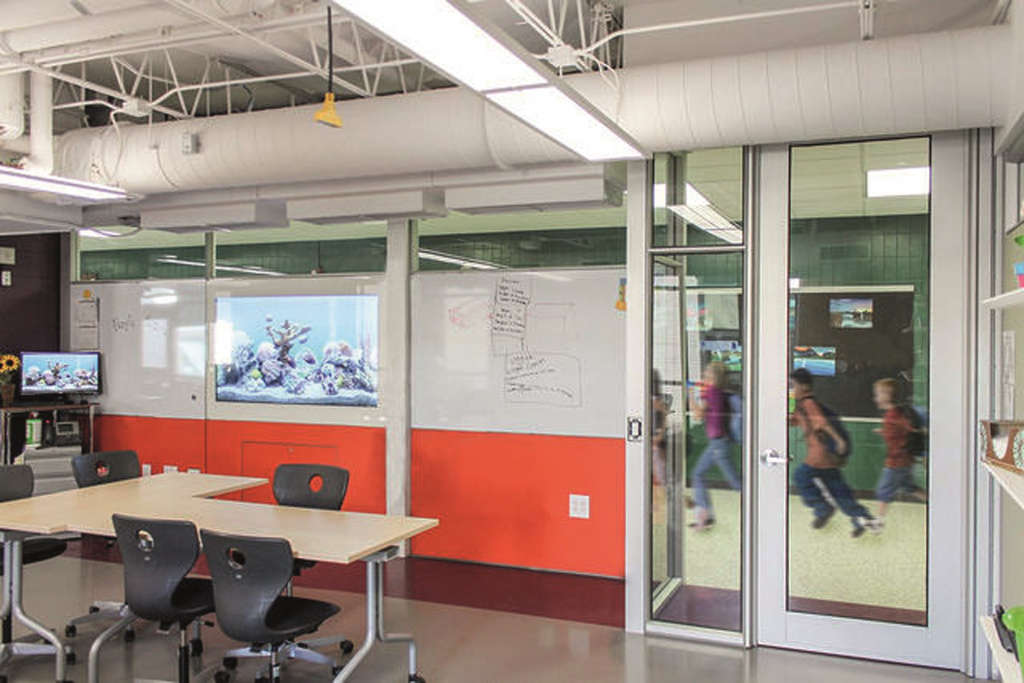The emerging trend in building curriculum-specific labs is frequently satisfied by remodelling obsolete general classrooms. Because these spaces are often relatively small, exciting transformations can take place over summer holiday months and kick start the new school year when students return. The dilemma of not having enough money can still be a challenge, but public, school districts are learning to build partnerships with their community members. In the case of one lab, successful professionals saw the value of giving back to their communities by funding an inspirational learning space for students.
1. River Trails Middle School STEAM Lab was part of a summer renovation project that included relocating the existing, interior administration suite which meant there was room to create a STEAM Lab with student project rooms right in the heart of the school opening for students in August 2016. The school had previously used a general classroom, typical of those throughout the school for STEAM projects. The new lab, however was thoughtfully designed around the specific activities that would take place in it: a large, flexible, central lab with flanking student project rooms. The exposed structure and higher ceilings showcased the building systems and provided drop-down access to electrics whilst the specification of rubber flooring was seen as more sustainable than the previous VCT floors as it did not require waxing. It also had a subtle pattern that no longer disrupts robots the kids work with: the floor in the room they had previously used had a busy/mottled pattern that confused the robots on their paths.

Technology is integrated directly into the primary teaching wall with dual screen monitors whilst the remaining walls are fully glazed enabling the teacher to maintain visual contact with all learners. Built from demountable panels, the configuration of the room can be altered should the school’s requirements alter in the future.
One of the project rooms incorporates a green screen setup for recording video whilst the doors open onto a courtyard meaning the room benefits from abundant daylight as well as opportunities for students to use the outdoor space for experiments. The FFE solution uses height-adjustable, ergonomic task seating and flip top/nesting tables support project work and enable quick reconfiguration of the Lab. Storage is in mobile cabinets that organize project materials and can be moved wherever needed.
Its success can be evidenced in the numerous accolades received by the practice. “The STEAM Lab versatility allows for more creative scheduling options” commented the middle school principal Keir A Rogers, whilst STEAM teacher Jeannine Wagner observed “When people enter this classroom, they feel the creative energy, and are primed to think and work more freely. Over the past year,” she continued “we’ve noticed a shift in the way students approach this subject matter. Students used to ask, is this project an “A”? Now they feel so much a part of a larger creative process that they work to prove the worthiness of their solution or outcome. The environment has definitely given students the feeling that they are part of something bigger than school.” “Being able to collaborate with a team of professional architects and designers has allowed us to work in the very same manner we are striving to teach” she continued. “We want students to know that each one of us doesn’t need to be an expert at everything. But each one of us has an expertise to share with the team, which strengthens the team to bring about the best outcomes. This has served as a model for success that I share with my students.”
"We want students to gain strong design thinking and problem-solving skill sets. We want to prepare students for (their) future (not our past) which will most likely include the development of critical thinking skills, ability to communicate with peers and the global community through all types of social media and traditional medium, the experience and understanding of collaborating in real time as well as in virtual environments, and finally, be open to creativity and the spirit of innovation"
Dr.Matt Silverman - Assistant Superintendent for Curriculum and Instruction, River Trails School District.